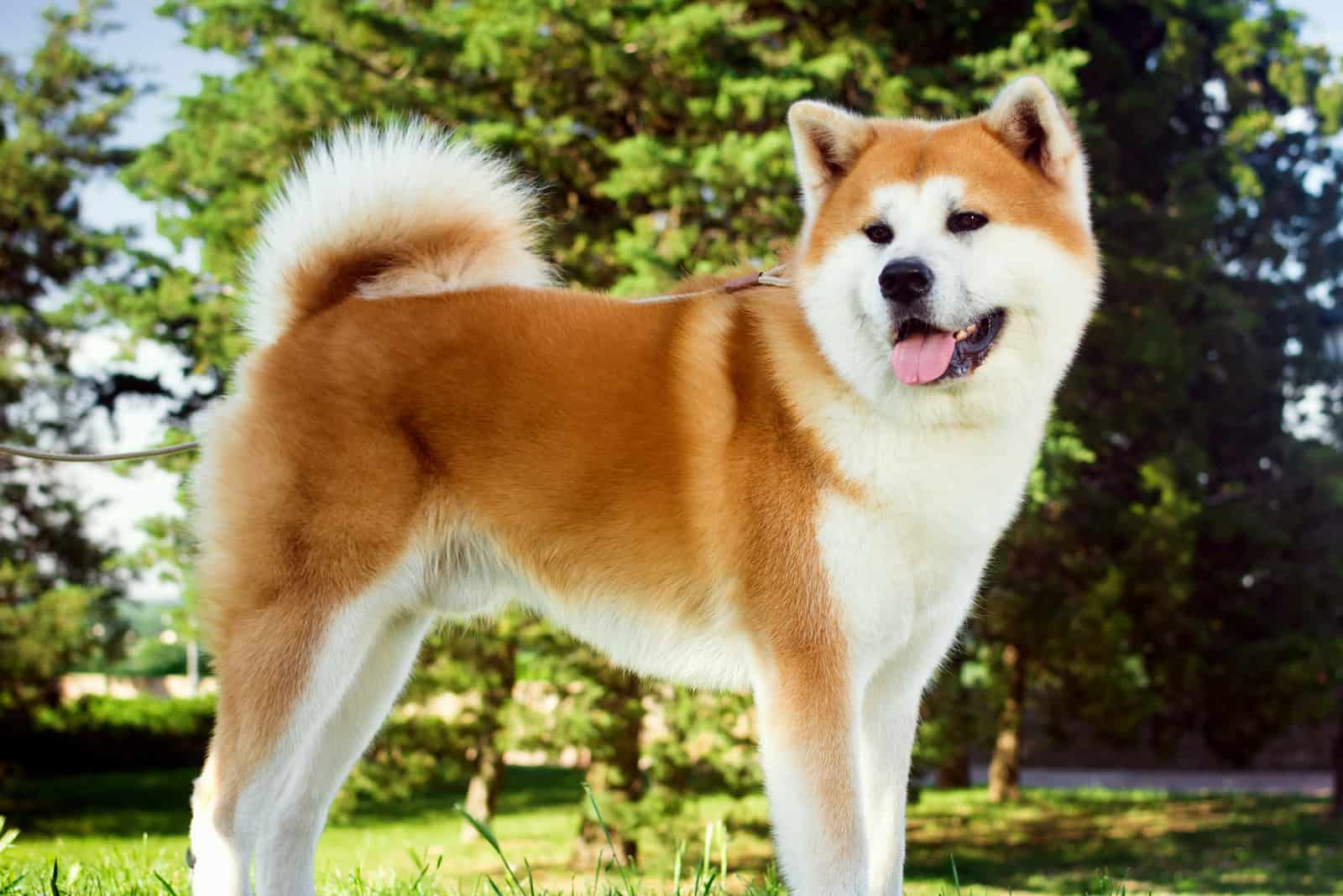You’ve been looking into getting yourself a German Shorthaired Pointer puppy, but you can’t decide whether to get a girl or a boy.
It’s a tough one, isn’t it? The GSP is a fantastic dog with many excellent qualities, but should you go for a male or female?
If you’re struggling with this decision, help is at hand with our guide to male Vs female German Shorthaired Pointers!
The GSP: A Short History
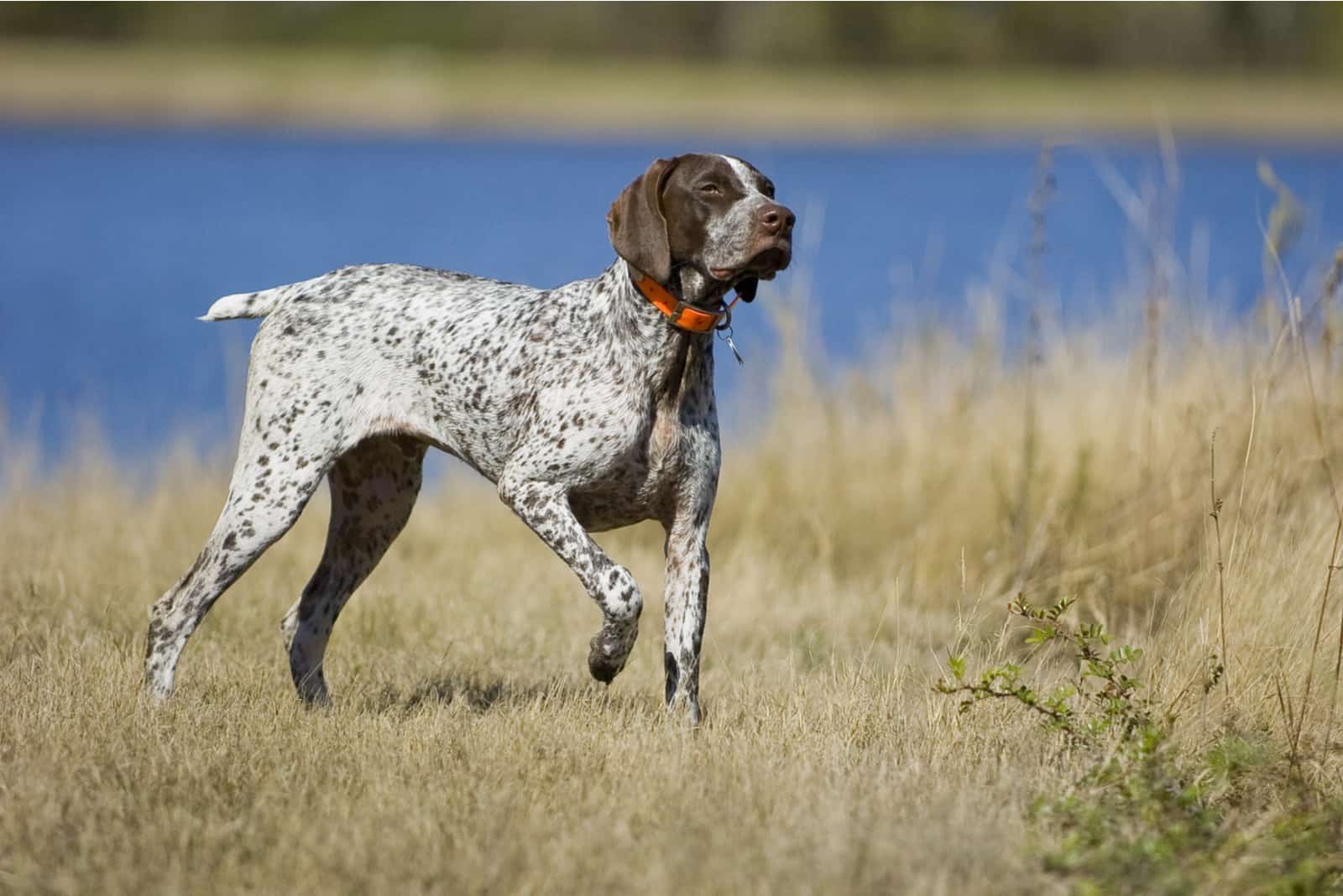

Before we begin, we’ll take a quick look at the German Shorthaired Pointer’s history to get some background information. This will help us understand some of the breed’s character traits and behaviors.
The GSP evolved from German bird dogs in the 1700s, soon becoming a valued hunting dog in its native country by the 1800s.
It’s believed that several breeds contributed to GSP, including Spanish Pointers, English Pointers, and other German scenthounds.
These gun dogs were prized for their exceptional hunting ability, flushing out and retrieving prey, such as pheasants, ducks, rabbits, and even deer. Their webbed feet make them great swimmers, a skill they love to indulge in today.
They earned the name Pointers from their habit of pointing their muzzle in the direction of prey when they detect its scent. The dog stands perfectly still with its head lowered in line with its back, usually with one foreleg raised with the paw bent back toward the body.
Although it retains these strong hunting instincts, there’s far more to this dog than engaging in the killing of wildlife for fun.
As with most dogs these days, they are kept as beloved companions in many households. And as long as they are given a job to do, along with plenty of love, they are very happy.
Male Vs Female German Shorthaired Pointers: Temperament


Both the male and the female GSP are loving, friendly, affectionate dogs.
However, they differ in several ways:
Males have the edge in being more eager to please you, while the female is slightly less so.
Although both are high-energy dogs, the male tends to be the more playful of the two. Females love to join in the fun but don’t have the same capacity for endless frolics and games as males.
The female matures mentally several months before the male. This may explain why she is less puppyish in her behavior. She is more independent and will respect your space when you need it.
Males are more clingy and attention-seeking and retain their puppy behavior for many years. They mature physically sooner than females, but mental maturity comes much later.
Both have a high prey drive and need constant supervision while out walking. It’s best to keep males on the leash as much as possible unless you are absolutely confident in their ability to obey commands.
Females are more manageable in this respect, as they are more likely to respond to training that teaches them to stay close and not bolt when off the leash. Males are more impulsive and may run off when they spot a squirrel or catch an exciting scent.
The key to overcoming this is early socialization, obedience training, and building the bond of trust between you.
One helpful tip when it comes to training male dogs of this breed is that they are more motivated by food than females. This could work in your favor as they’re more likely to comply!
On the whole, this is not an aggressive breed. However, males can be protective of the home and family, while females tend to protect their favorite person. Both make excellent watchdogs as they will always alert you to the presence of visitors or intruders.
These dogs are good with kids and generally okay with other dogs, though the males may be too clumsy and bouncy around children and harm them unintentionally. Males are also more suspicious of other dogs but will usually be okay with strangers.
Females are the opposite; they are more likely to trust other dogs and animals but may be wary around unfamiliar people! They are more cautious when kids are involved and less likely to knock them down in their enthusiasm.
Both will get along better with a dog of the opposite sex.
Now we know more about what makes them tick, let’s see what other differences we can discover!
Male Vs Female German Shorthaired Pointers: Size
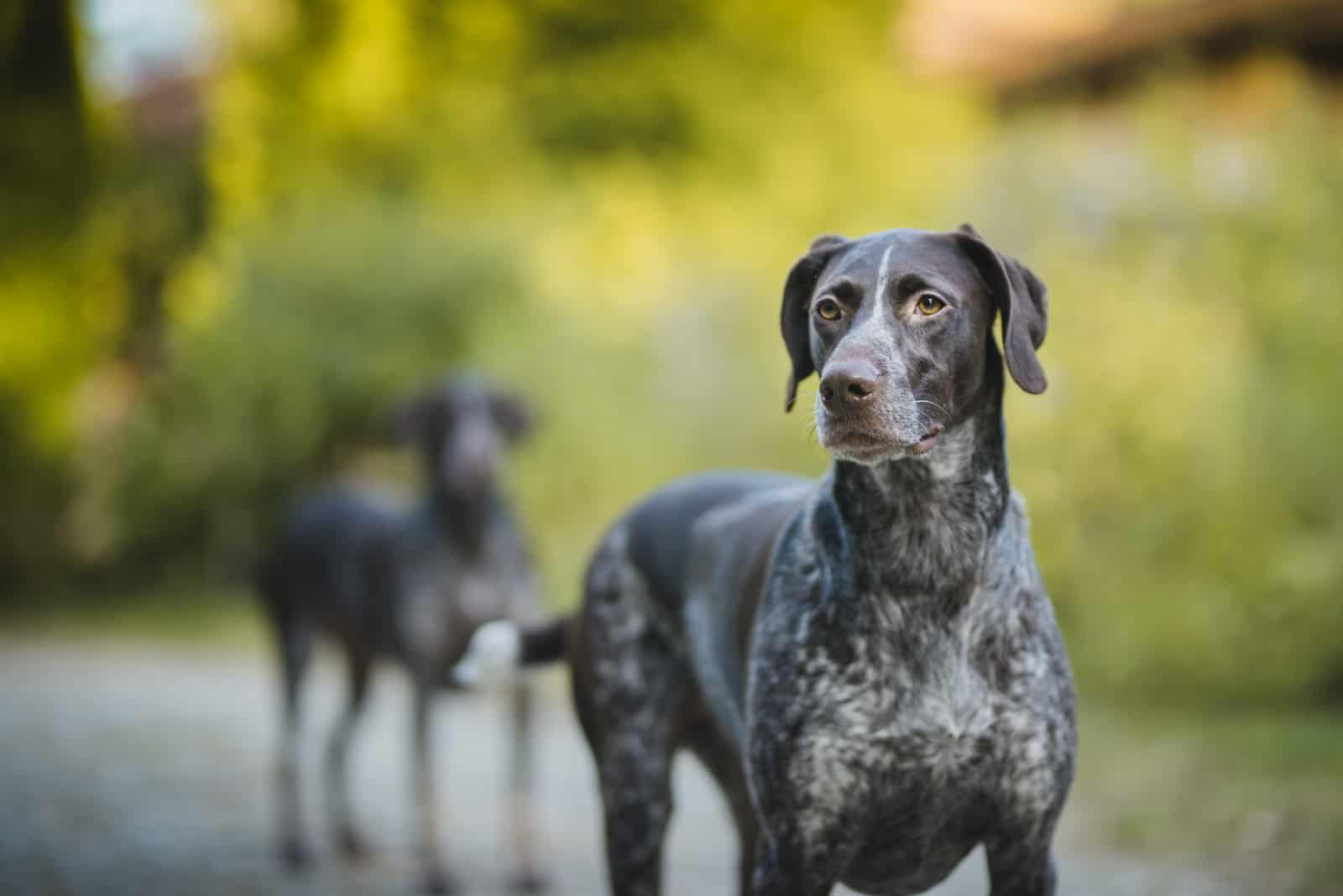

As with most dog breeds, the males tend to be bigger than females:
Male German Shorthaired Pointer
| Height: | 23 to 25 inches at the shoulder |
| Weight: | 55 to 70 pounds |
| Appearance: | noticeably bigger than the female with a thick, muscular body and heavy jowls. |
Female German Shorthaired Pointer
| Height: | 21 to 23 inches at the shoulder |
| Weight: | 40 to 60 pounds |
| Appearance: | slender neck and body, lighter in weight, and lacks the males’ jowls. |
How does this play out in our male Vs female German Shorthaired Pointers guide?
While you might believe that the size difference between the two wouldn’t matter, a fully-grown male GSP is significantly stronger and heavier than a female that’s on the lower end of the scale.
A thirty-pound weight difference, along with powerful muscles, is something to consider when you have them on a leash. Even a well-trained dog can catch you off-guard and pull toward something that has taken its interest!
And while both the male and female dogs are going to get through a sizable amount of dog food throughout their lives, a big male will generally eat more to maintain its muscular frame.
Male Vs Female German Shorthaired Pointers: Health Issues
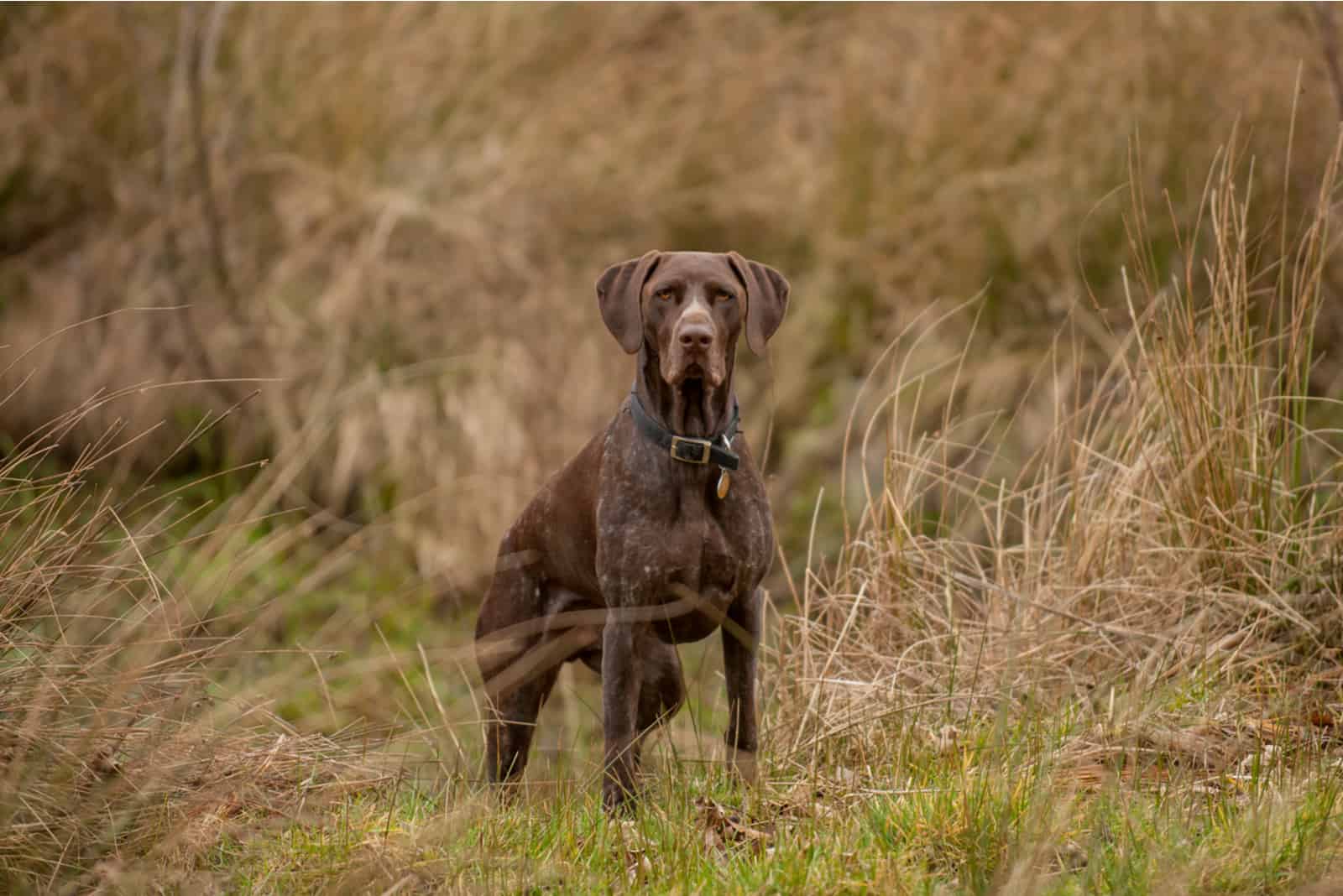

In most purebred dog breeds, there isn’t much difference between males and females when it comes to health problems.
This is primarily the case with the GSP, where box sexes are equally at risk of the following conditions:
Hip dysplasia is a chronic condition caused by a malformed hip joint. It’s a hereditary condition that often leads to arthritis in old age (if not well before then). Mild cases can be controlled using pain relief and anti-inflammatories.
Surgery is often required in severe cases where the dog’s mobility is affected.
Progressive Retinal Atrophy (PRA) is a collection of eye conditions that eventually cause blindness. There is no cure for this, and any treatment is aimed at preparing the dog for life without sight.
Lymphedema is a problem with the dog’s lymphatic system (filters the blood and delivers proteins to the bloodstream). With lymphedema, a blockage stops the flow of fluids, which gather in the dog’s body, causing swelling, usually in the face, legs, or belly.
Secondary lymphedema (caused by trauma, surgery, or sickness) is treatable, but if the dog has inherited the condition, there is no cure at present. Severe cases can prove fatal.
Bloat, otherwise known as gastric torsion or gastric dilatation-volvulus (GDV), affects large, deep-chested breeds (like the Great Dane, German Shepherd, Doberman Pinschers, etc.).
Bloat usually occurs soon after the dog has eaten or drunk too much too quickly, especially after vigorous exercise.
The name ‘bloat’ refers to the dog’s stomach, which swells with gas or fluids. This stops anything from getting in or out, and the stomach inflates further, which is incredibly painful.
In many cases, the stomach twists around on itself (the torsion or volvulus part), stopping the blood supply to vital organs. If this wasn’t bad enough, the pancreas goes into panic mode and fires off a bunch of toxins that can stop the dog’s heart!
Emergency treatment, including surgery, is essential for the dog’s survival.
It’s advisable to learn the signs of bloat as it might just save your dog’s life.
Von Willebrand’s Disease is caused by a lack of a specific protein. Dogs with this bleeding disorder may suffer from spontaneous bleeding from the nose and mouth and will be at risk of severe bleeding from minor injuries.
Surgery presents a serious challenge as it is difficult to control or limit blood loss. Again, there is no cure, although blood transfusions will increase the levels of the protein in question.
Entropion is caused by hairs on the eyelid scraping against the cornea, which irritates the eye and can lead to ulcers. Although it can be treated using ointments and lubrication, surgery is usually necessary as a long-term solution.
Epilepsy is common in many dog breeds, although some are more prone than others. Seizures can result from poisoning, trauma, or fever, which is known as structural epilepsy.
Cases where the cause is unknown are usually referred to as idiopathic epilepsy, although the condition is inherited in most cases.
With the exception of bloat, you can reduce the risk of all of these health conditions by choosing a reputable breeder.
Good breeders always test their parent dogs for common genetic diseases and exclude any dog from the breeding program if they aren’t suitable.
In relation to male Vs female German Shorthaired Pointers, there’s not much evidence to suggest that one sex is more prone to have any of these conditions than the other, with the possible exception of hip dysplasia.
In fact, the male GSP seems to have an increased risk of joint problems overall because of its heavier body and skeletal frame.
Also, it’s reported that males suffer from breathing difficulties and have an increased risk of heart problems, simply because they weigh more than females.
Some sources even go as far as to suggest that females live longer than males because of this.
Male Vs Female German Shorthaired Pointer: Grooming
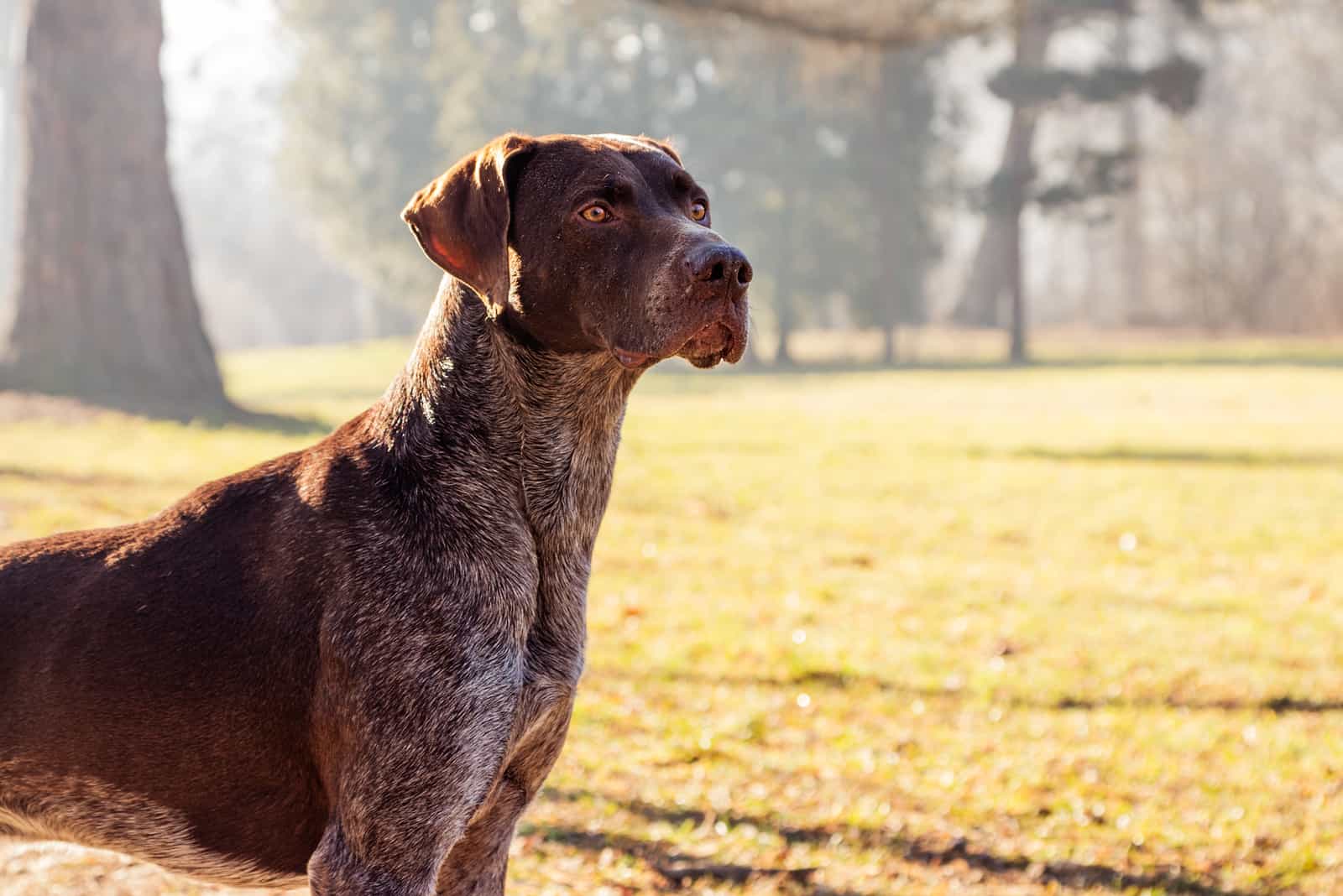

Overall, this is a low-maintenance breed that doesn’t require much effort when it comes to grooming. Both males and females have a short, flat coat (hence the name!) that needs brushing at least once a week.
This controls the amount of shedding and keeps the skin and coat healthy. You can use a brush with firm bristles or a grooming mitt to do this job.
They only need bathing every two or three months; washing too frequently will dry out their skin and cause irritation.
As they are active dogs that love exploring the great outdoors, there’s a good chance that they’ll get caked in mud. If possible, wash them down with clear water or wait for the mud to dry and brush it out.
Your dog’s teeth need brushing at least once a week, and you should clip their nails regularly. If toenails are left to grow long, they can be painful to walk on or even get ripped out while the dog is running.
Check your dog’s floppy ears weekly and use ear-cleaning drops. Gently wipe away any gunk and make sure the ears are clean. Floppy-eared dogs are more prone to infections, so it’s vital that you remember to do this.
As for male Vs female, there’s really no difference here; both sexes need regular grooming to keep them healthy.
Male Vs Female German Shorthaired Pointer: Exercise


Your dog will need at least an hour of exercise every day.
Males will most likely need more than this because they are generally more active and have higher energy levels.
These dogs are not cut out for city life, and they need plenty of space to run around, like a large, secure yard. The word secure is essential here: male GSPs are excellent escapologists, especially intact males (that is, not neutered) that detect a female in heat.
And, as your frustrated boy dog can detect the scent of a female in heat up to three miles away, he’ll go all out to find an escape route to find her.
Because of this, your yard must have high, secure fences! Your furry pal will then be able to play and run to his or her heart’s content.
Your dog, male or female, will love long walks. Males will be better on the leash unless they are thoroughly trained and you trust them not to bolt after the nearest small wildlife or a neighbor’s cat.
They love nothing more than a good swim or a hike through the country – it’s what these dogs were made for.
Adequate exercise keeps your dog fit both physically and mentally. Intelligent dogs need to keep their minds active and occupied, or they become bored.
This can lead to frustration which will spill over into bad behavior, even aggression. So, it’s essential to make sure your dog has enough mental stimulation. This breed is built for sports! Sign up to canine agility courses, fly-ball, obedience trials, tracking trials, etc.
Play games at home that involve finding hidden objects, make your dog work for its dinner or you could even build an obstacle course in your backyard.
As the old saying goes, a tired dog is a happy dog.
This is very true for the GSP of either sex.
Male Vs Female German Shorthaired Pointer: Lifespan
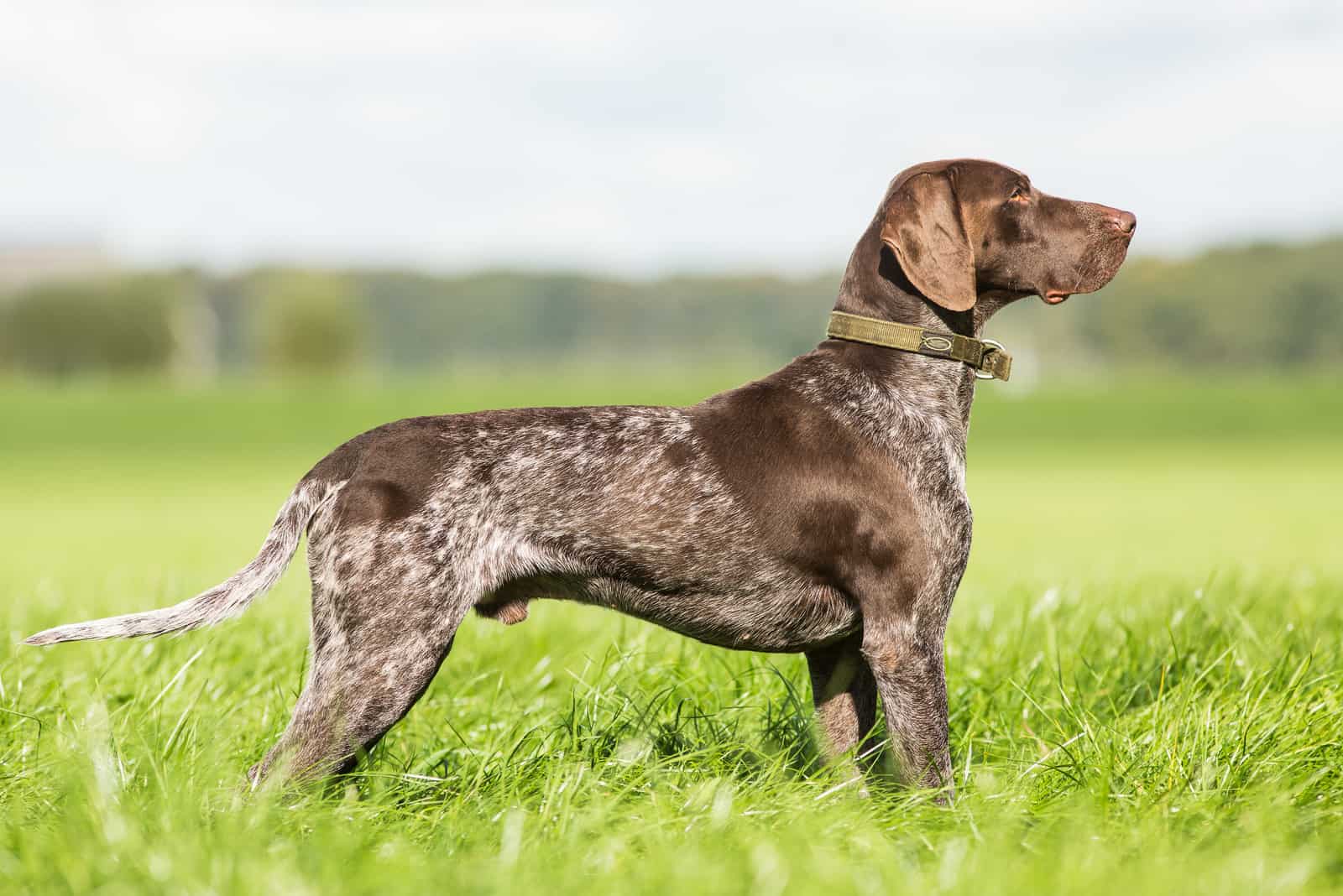

As we learned in the previous section, male German Shorthaired Pointers possibly have a slightly reduced life expectancy because of their bigger size.
While the evidence isn’t conclusive, it’s definitely something to keep in mind when comparing the two. Most studies suggest that females outlive males by about one year.
The American Kennel Club states (AKC) that this breed has a lifespan of between 10 to 12 years, which is the average for all dog breeds.
However, other sources put this figure at 12 to 14 years, which is quite a difference!
One study puts the median age of death at nine years, while another found it to be 12, so who is right?
Although the reasons for these different figures aren’t clear, the studies were conducted by very different groups across several countries. The best we can say is that the results were influenced by local factors or that the data was somehow incomplete.
If we go with the middle ground, we get a figure of around 12 years, although a healthy dog can reach 15 years and possibly more.
This is another reason for using a reputable breeder, as your furry friend has an excellent chance of living a fulfilling and happy life.
Male Vs Female German Shorthaired Pointer: Price


On average, a GSP puppy will set you back around $1,000.
However, prices range from $600 to $1,500 for a good quality dog from a reputable breeder. The difference in price usually reflects what you’re getting for your money and how experienced the breeder is.
Breeders charge more for AKC registration, good pedigrees, and pups from championship bloodlines.
Of course, you can spend more if you wish. A GSP puppy that’s been trained specially for hunting will cost somewhere between $3,000 and $5,000.
However, if you don’t give two hoots about this and can’t abide the idea of hunting, you can still get a healthy dog for between $600 and $1,000. Be very wary of anyone who charges more than $600 if the pups aren’t AKC registered.
In relation to our central theme of male Vs female German Shorthaired Pointer, the female GSP usually costs a little more.
This is based on the tradition that females have breeding potential, but seeing as most breeders have a spay and neuter clause in the sales agreement, this doesn’t seem right somehow.
It’s worth questioning your breeder why you should pay more for a female if there is no breeding potential!
Are German Shorthaired Pointers Aggressive?


By all accounts, the GSP is not an aggressive dog! They were bred as hunting companions that were loyal and affectionate to their owners. All their energy is channeled into their work and pleasing their owners.
However, any dog has the potential to be aggressive depending on the circumstances.
Fear, anxiety, pain, and sickness can all make a dog behave aggressively. Dogs with a history of abuse can, understandably, also display aggressive behavior.
It all comes down to knowing the signs and understanding what the problem is. We also need to be able to tell the difference between aggression and natural displays of protective behavior.
Dogs use a variety of ways to get a message across, like barking, growling, or snarling. None of these signs are necessarily aggressive. Actual aggression is never nice to see and almost always ends with physical violence.
A German Shorthaired Pointer that’s well-loved and cared for will rarely, if ever, behave aggressively toward humans. Some new GSP owners are a little uncertain or surprised at first when their dog barks at them.
This breed will often bark at you when you arrive home. They’ll do the same to strangers, and it can be difficult to tell whether this is a warning or a warm welcome!
The only areas of concern for the GSP when it comes to aggression are their strong prey drive and the tendency of the male dog to be protective when other dogs are around.
The instinct to hunt small prey is deeply ingrained, and it can be shocking to see how your pup changes from a happy-go-lucky pooch to a snarling beast as it single-mindedly chases down a defenseless animal.
Likewise, it can be unsettling if your furry friend reacts badly when around other dogs. Nobody wants their pooch to be the one that misbehaves when in the dog park or out for a walk.
The male GSP is bigger and more muscular, making them more challenging to control. In addition, they’ll probably be on a leash, which makes the problem worse. Leash aggression is a common problem as it makes dogs naturally defensive.
When they’re not restricted, dogs usually approach each other side on, rather than head to head. They observe each other’s body language and then begin the sniffing ritual.
Being on a leash automatically puts them at a disadvantage; they can feel trapped and unable to retreat if needed. This forces them to be confrontational, resulting in snarling and barking. And sometimes it leads to physical attack.
Few GSPs will ever go this far, but it all depends on the individual dog’s personality. It also depends on how well trained and socialized they are.
We can’t stress the importance of proper training and socialization enough! Seriously, you will save yourself a whole lot of hassle and stress if you commit to socializing and training your new puppy as soon as you get them home.
This is also where good breeders can help. Some will begin training their pups very early. By the time you pick up your new puppy (between 8 and 10 weeks), it will already know a handful of basic command words.
As for socialization, this is arguably even more important. Many breeders live in country settings on farms and ranches or have ample land for the pups to explore as they develop.
The puppies are exposed to various experiences, animals, sounds, and scents that prepare them for life ahead. Because of this, they are more able to handle new experiences later.
They get used to being around other dogs and are able to judge whether something is a real threat or not. This makes your life much easier when you get the pup home, but the process doesn’t stop there.
It’s now up to you to continue training your puppy and helping it to learn to accept the presence of other people, dogs, and animals.
The male GSP will possibly present more of a challenge, but it’s well worth the effort. By the time your little furball reaches six to eight months of age, you’ll have a happy, well-adjusted dog that’s an absolute pleasure to be around.
Why Shouldn’t You Get A German Shorthaired Pointer?
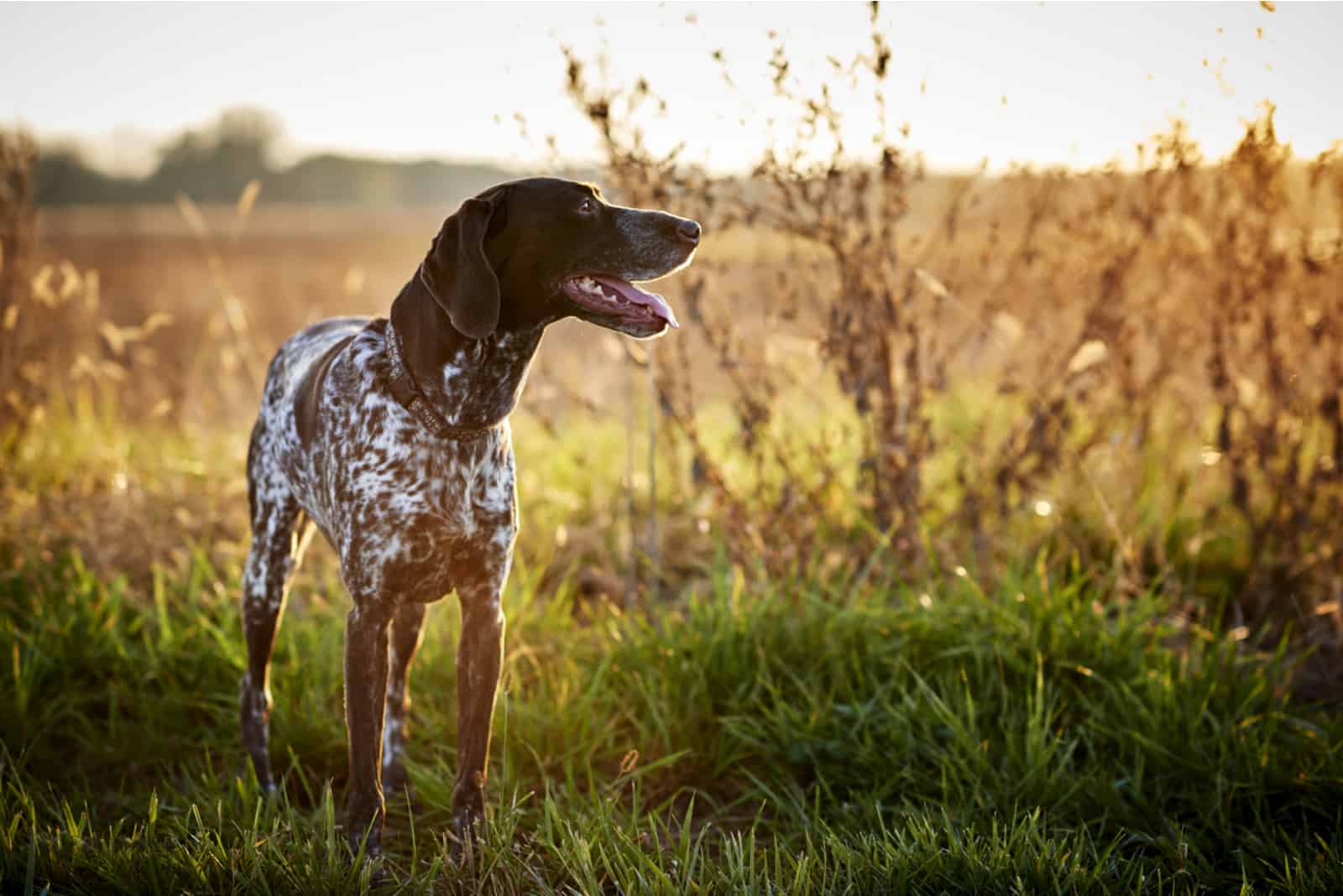

We’re taking a break from our male Vs female German Shorthaired Pointers guide to recognize an important fact: this dog is not suitable for everyone.
Why is this? Let’s find out!
High energy
GSPs are an excellent match for active families who enjoy outdoor pursuits. Long walks and hikes in the mountains and forests are ideal, and your GSP will be in its element. Be sure to sign your dog up for all kinds of doggy sports events, and they’ll be happy as can be.
Separation anxiety
The GSP lives for its humans; nothing is more important to them than you! They crave your companionship and don’t handle your absence well. When left for long periods, there’s a pretty good chance they’ll wreck your home while you’re away.
This is not a good choice as a guard dog that will be left outside on its own all day.
Prone to jumping up
These are highly excitable dogs that make a real fuss over the slightest thing, like meeting new people. They have a tendency to jump up to say hello, which some folks aren’t happy about, and dangerous to small kids or frail elderly.
Training can help to ease this problem, but it remains a potential problem for the first few years of their lives.
Extremely strong prey drive
The hunting instinct is very strong in the GSP, particularly in sporting dog breeding lines. This can spell trouble if you have small pets (rabbits, hamsters, cats, etc.) or when your dog spots a squirrel, as your dog may chase them down.
GSPs have been known to harm or even kill small animals if they get the chance. Once again, training and socialization are your friends here.
Wilful and stubborn
Intelligent dogs like to do things their own way! If you’re not careful, they’ll make their own decisions, especially if you leave obedience training until they’re older than ten weeks.
Training will be a challenge to begin with. There’s a good chance that your GSP puppy will be distracted by everything and won’t pay attention. However, in the end, the desire to please you will overcome this problem if you remain persistent.
For all these reasons, the GSP, whether male or female, is not the best choice for first-time dog owners! However, if you have experience of owning dogs and feel you can handle the challenge, then this could be the dog for you.
How does this affect our male Vs female German Shorthaired Pointer guide?
As you’ve seen in the temperament section, the male GSP is probably more hard work in terms of all these points here. Although each dog is different, we have to admit that the female GSP looks like a winner here!
Do German Shorthaired Pointers Have a Favorite Person?
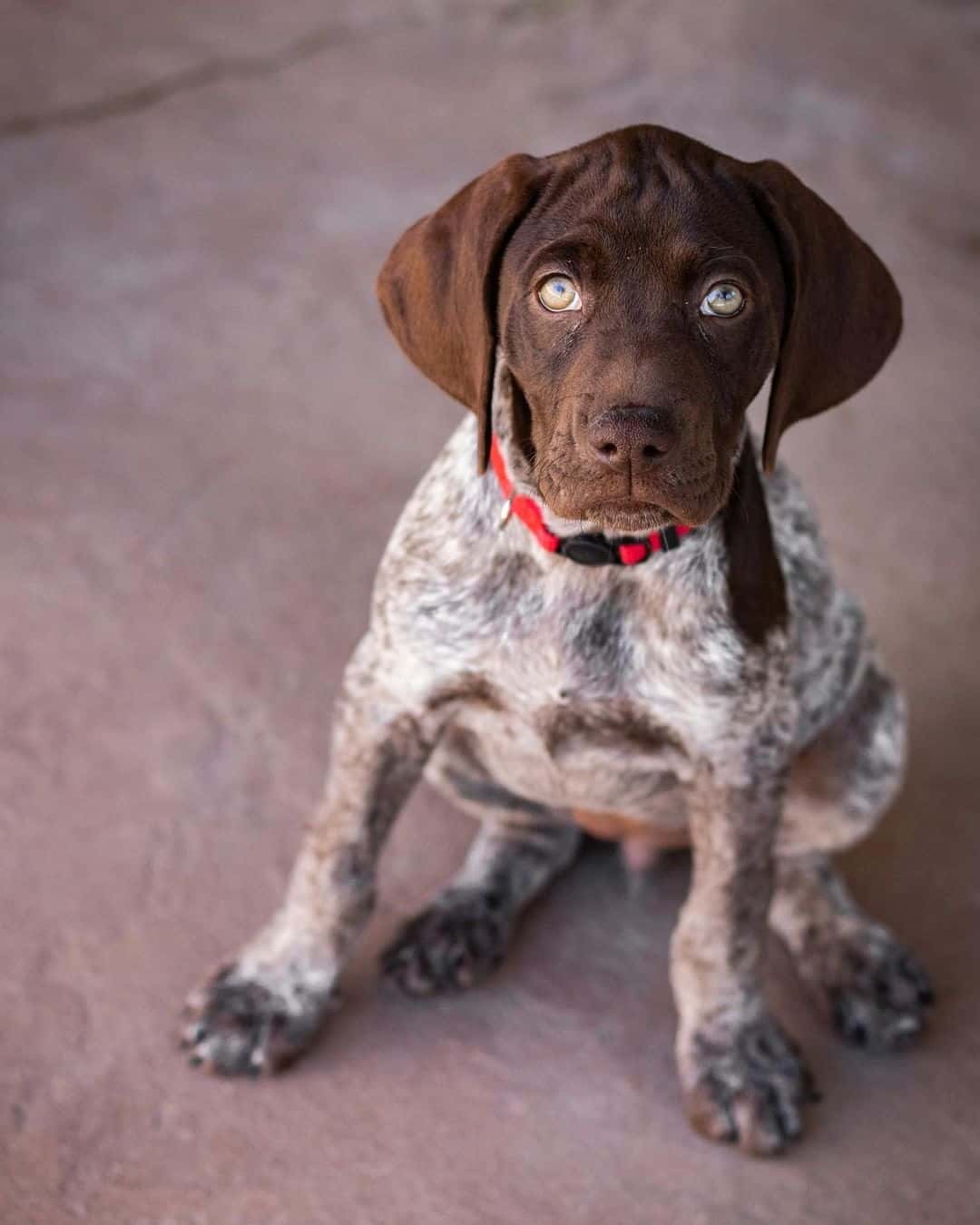

Photo from: @germanshorthairedpointer.world
Some breeds are known to form a strong bond with one family member, usually the one they identify as the pack leader.
So, for the purposes of male Vs female German Shorthaired Pointers, is this breed the same?
The answer is, it depends!
Male dogs in this breed like to share the love and are affectionate to all family members equally. They are more likely to be affectionate and clingy.
On the other hand, female GSPs will often focus their affection on a single person, which is usually the one they identify as the pack leader.
This doesn’t mean she will ignore everyone else, just that she’ll pay special attention to that chosen person.
Male Vs Female German Shorthaired Pointers: Conclusion


So, which one wins? Are male GSP dogs better than females? Or would a female be the better choice as your new puppy?
The honest truth is, it’s not our job to say! We’ve given you the details; now it’s up to you. The truth is, both sexes are brilliant and will be loving, devoted, loyal, affectionate companions.
It all comes down to which one suits you and your lifestyle best.
Here’s a quick recap to help you:
Male GSP
• Lives to please you
• He loves being fussed over and is an attention seeker
• Short attention span and more challenging to train
• More bouncy, can be clumsy and knock down kids or older folks
• Physical maturity happens quicker than mental maturity
• Pretty easy to socialize with people
• Motivated by food
• Not as good around other dogs and animals as the female
• Bonds with all the family and can be protective
• Not as naturally clean as the female
• More likely to be aggressive than the female (see the section on aggression above)
Female GSP
• Not as endlessly playful as the male
• Shows independence at times and won’t constantly seek attention
• Females generally have a better attention span and are easier to train
• More restrained and careful around kids
• Not so easy to please you as the male
• Not as motivated by food
• Protective over one family member over the others
• Less inclined to aggression
• Can be cautious of strangers and more difficult to socialize with people
• She matures mentally before she does physically
• Gets on better with other dogs and animals
Whichever one you go for, you need to be ready for the challenge. These dogs need people that can cope with their energy level, so they would be a great match for a sporty, active family. Swimming, hiking, and running are all great ways of keeping this dog healthy and happy.
You’ll need to commit to dog obedience training sessions from a young age, or you’ll be storing up trouble for later.
Socialization is essential in taming some of those powerful instincts. Seriously, you’ll do yourself a real favor by getting your pup used to other dogs, animals, and people.
And now there’s not much left to say except, choose wisely, give your pup all the love and care it needs, and enjoy every minute together.

